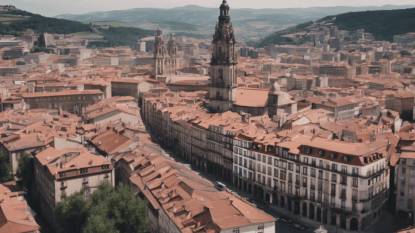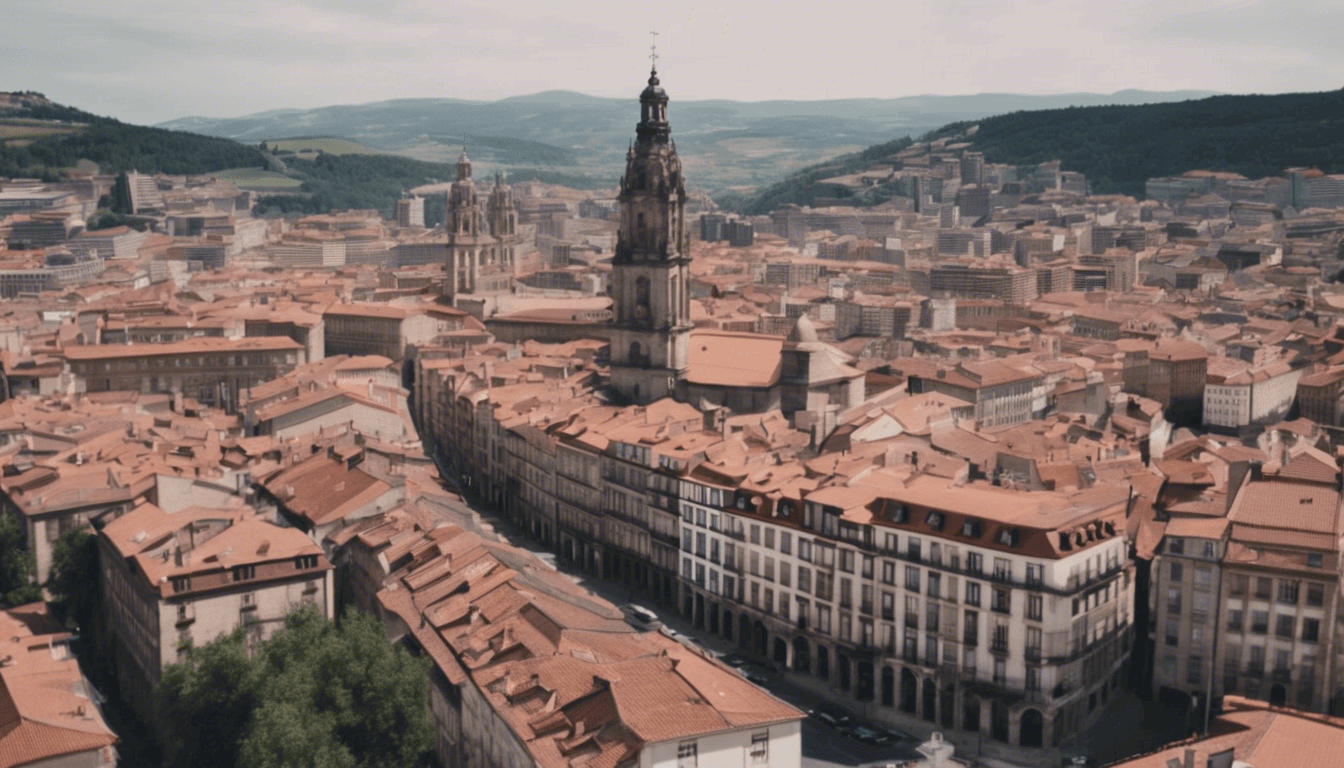
Santiago de Compostela: The Ultimate Visitor's Guide
Posted: | Updated:
Reading time: 43 minutes
Santiago de Compostela: The Ultimate Visitor's Guide
Posted: | Updated:
Reading time: 43 minutes
By: Simon Kemp, Editor
Welcome to Santiago de Compostela
Santiago de Compostela, in Spain’s lush Galicia region, is a gem waiting to be explored. This historic city is a treasure trove of Gothic and Romanesque architecture, with its streets and buildings steeped in centuries of tradition and stories. Recognized globally for its cultural and historical value, Santiago proudly holds a spot on the UNESCO World Heritage Site list, distinguishing it as a place of universal importance.
But there’s more to Santiago than its stunning visuals. It’s the culmination of the Camino de Santiago , an epic pilgrimage route that draws thousands of visitors each year. Whether they’re walking for faith, reflection, or adventure, pilgrims of all ages find their way to this city, marking the end of a journey and the beginning of personal revelations. Santiago de Compostela is a destination that promises an unforgettable experience.
Imagine stepping off a plane, train, or bus and being immediately immersed in the culture of Santiago de Compostela. This city, a jewel in the crown of northwest Spain, is a treasure trove of stunning architecture, historical landmarks, and the world-renowned pilgrimage route, the Camino de Santiago.
Map of Santiago de Compostela
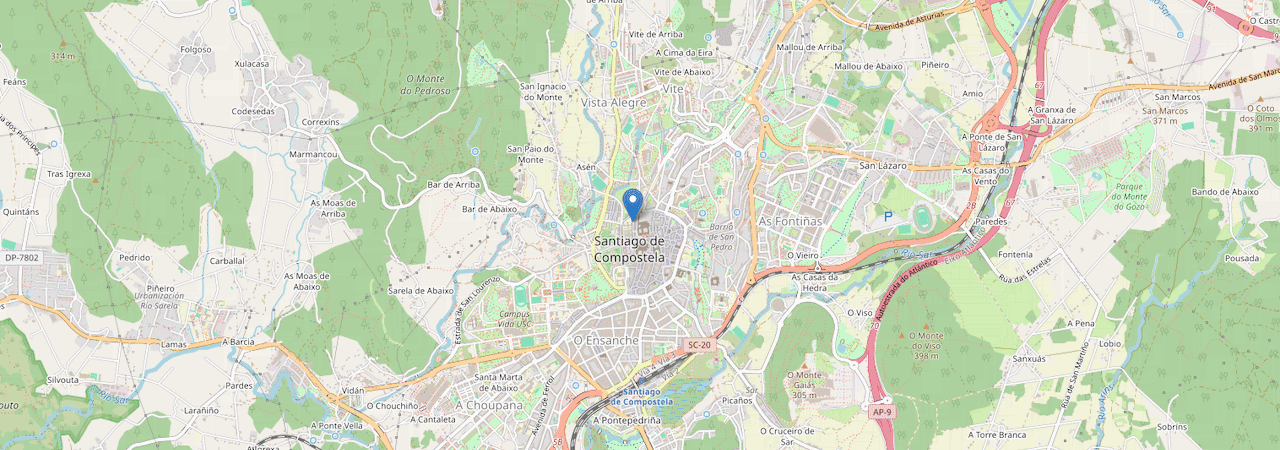
How to get to Here
For those of you who are intrepid Pilgrims and are making the journey to Santiago de Compostela across one of the Camino de Santiago routes, then you already know how to get to Santiago - the hard (devoted) way. For other travelers who prefer to fly direct to the city, it has a lot of international connectivity. Here is a list of some of the countries, airports, and cities that have direct flights to Santiago-Rosalía de Castro Airport (SCQ).
Direct flights to Santiago-Rosalía de Castro from Europe
| Country | City | Airport Code | Airline |
|---|---|---|---|
| UK | London Gatwick | LGW | Vueling |
| UK | London Stansted | STN | Ryanair |
| France | Paris | CDG | Vueling |
| Germany | Cologne-Bonn | CGN | Eurowings |
| Germany | Frankfurt | FRA | Lufthansa |
| Germany | Memmingen | FMM | Ryanair |
| Portugal | Funchal (Madeira) | FNC | Iberia |
| Italy | Bologna | BLQ | Ryanair |
| Italy | Milan (Bergamo) | BGY | Ryanair |
Direct flights to Santiago-Rosalía de Castro from Spain
Of course, there are many direct flights and connections to Santiago-Rosalía de Castro from within Spain, here are most of the available routes.
| Country | City | Airport Code | Airline |
|---|---|---|---|
| Spain | Madrid | MAD | Ryanair, Vueling, Iberia |
| Spain | Barcelona | BCN | Ryanair, Vueling, Iberia |
| Spain | Bilbao | BIO | Ryanair, Vueling |
| Spain | Seville | SVQ | Ryanair, Vueling |
| Spain | Palma de Mallorca | PMI | Ryanair, Vueling |
| Spain | Málaga | AGP | Ryanair, Vueling |
| Spain | Tenerife (Los Rodeos) | TFN | Binter Canarias |
| Spain | Tenerife (Reina Sofía) | TFS | Binter Canarias |
| Spain | Valencia | VLC | Ryanair, Vueling |
| Spain | Gran Canaria (Las Palmas) | LPA | Binter Canarias |
Navigating a new city can be challenging. But fear not, here is some practical information to help you smoothly navigate from the airport or station to the heart of the city.
Transfer from the Airport or Station to the City Center
There are a few convenient options here. The bus and train transit options are extremely affordable and of course you can use a private taxi cab as transportation for you transfer to the city center.
| From | Method | Details |
|---|---|---|
| Airport | Taxi/Private Transfer | The fastest way to get from Santiago de Compostela Airport to the city center is by taxi or private transfer. The journey takes around 15-20 minutes, depending on traffic. |
| Linea 24 Bus | The cheapest way is by taking the Linea 24 bus. | |
| Train Station | Walking | The Santiago de Compostela railway station is only about 1.5 km (0.9 miles) from the city center. It’s possible to walk to your hotel. |
| Taxi | Alternatively, you can take a taxi. | |
| Bus Station | Walking | The bus station is on the high ground of Santiago, and Rua das Carretas is in the lower part, therefore, walking will be downhill for you. According to Google maps, it is a 1.6 Km distance or 20 min walking. |
| Taxi | Taking a taxi is also a very good option. |
History and Culture
The city has a rich history that dates back to at least the 9th century when it was believed that the tomb of the Apostle James was discovered here. This discovery turned Santiago into a major Christian pilgrimage site, with the construction of its famous cathedral beginning in the 11th century.
Over the centuries, Santiago has been a witness to numerous historical events, evolving into the vibrant city it is today. Its role as a spiritual center has attracted pilgrims and visitors from all around the world, contributing to the city’s diverse cultural fabric.
The local culture is deeply intertwined with the traditions of Galicia, a region known for its distinct identity within Spain. Galician culture is celebrated through its music, dance, festivals, and especially its language, Gallego. This language, alongside Spanish, is used daily by the locals, reflecting the region’s pride in its heritage.
Santiago’s streets and squares come alive with traditional Galician bagpipe music, while its culinary scene offers a taste of the rich Galician cuisine, known for its seafood and hearty dishes. The city’s traditions, from the religious fervor of the Camino de Santiago to local celebrations like the Feast of Saint James, showcase a community deeply connected to its past yet constantly evolving.
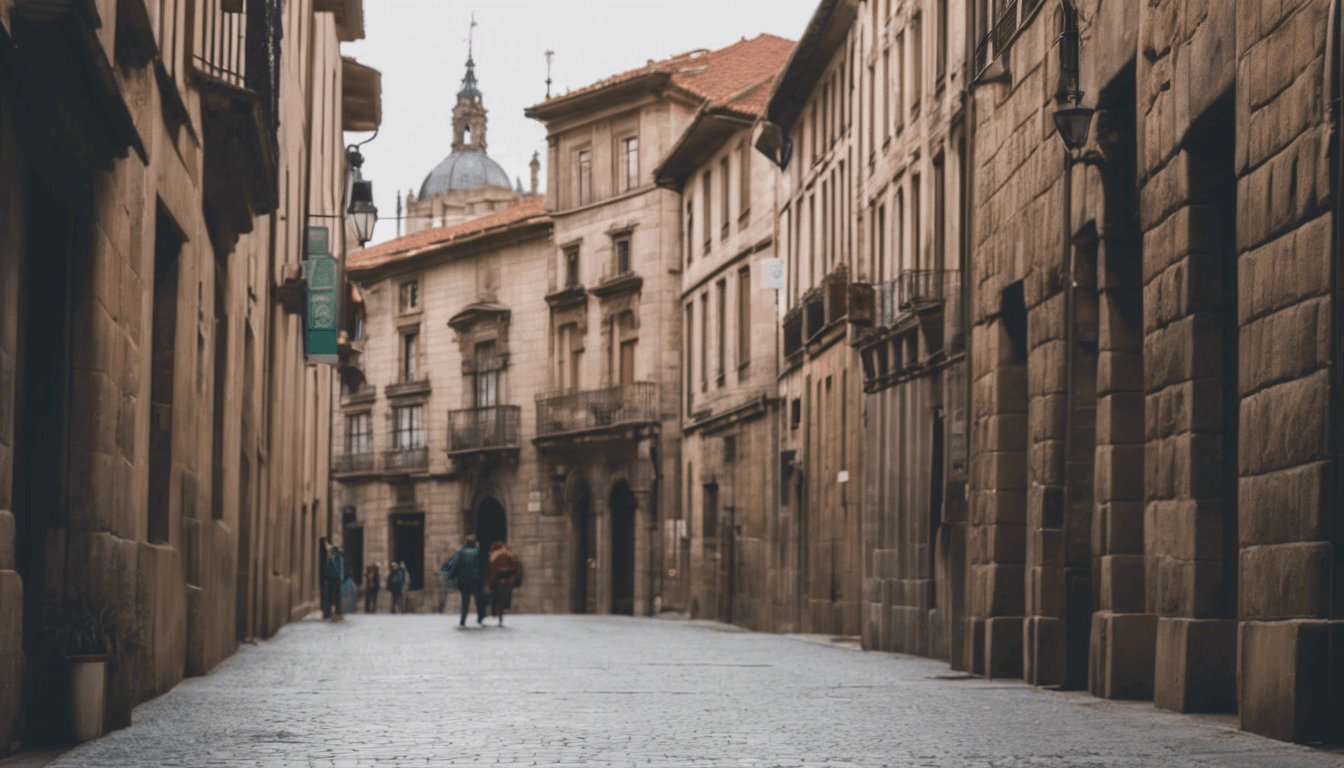
The Founding of Santiago de Compostela
This is a city steeped in history and culture that traces its roots back to the Roman Empire. The city’s founding is intertwined with religious legends, architectural marvels, and the ebb and flow of power among empires.
Notable Historic Events
Here is a list of some of the most notable events in Santiago de Compostela’s history:
- 1st Century: According to legend, the Apostle Santiago preached in the famous Hispanic finis terrae (end of the world) and, after returning to Palestine and being beheaded, his followers wanted to bring his body to this location, the farthest place where he preached.
- 4th Century: The area started as a Roman cemetery.
- 5th Century: It was occupied by the Suebi, a Germanic tribe, during the initial collapse of the Roman Empire.
- 7th Century: The area where the historic city is now situated was once known as Mount Libredón, it seems that it was once home to a Roman villa.
- 9th Century: The hermit Paio saw some lights lit up the ruins of an ancient necropolis. Theodomir the Bishop from the neighbouring Iria Flavia, examined and identified the remains of the tombs as being of the Apostle.
- 813-830: The discovery of the tomb of the apostle St. James, martyred at Jerusalem about 44 CE. His bones had been taken to Spain, where, according to legend, he had formerly evangelized.
- 834: The primitive church, consecrated in 834, has remained standing for no less than four decades.
- 874: After his pilgrimage to Santiago, the monarch Alfonso III ordered a larger temple to be constructed.
- 9th-12th Centuries: The cult of Santiago played a key role in Spanish resistance against the Muslim invasion of the northern territories.
- 997: The whole town, except the tomb itself, was destroyed by Abū ʿĀmir al-Manṣūr (Almanzor), military commander of the Moorish caliphate of Córdoba.
- 12th-13th Centuries: The town developed great importance. Pope Alexander III declared it a Holy Town, like Rome and Jerusalem.
- 1985: UNESCO designated the city a World Heritage site.
Accommodation
If you are planning to visit, the final destination of the Camino de Santiago pilgrimage route, you might be wondering where to stay in this beautiful and historic city. Santiago de Compostela offers a wide range of accommodation options, from pilgrim hostels to luxury hotels, to suit every taste and budget. Here are some tips for selecting the best place to stay based on location, budget, and preferences.
Budget
If you are looking for a more affordable option, you can find some cheaper hotels and hostels in other areas of the city, such as the new town or the outskirts. For example, you can stay at the Hotel Windsor, a simple but comfortable hotel near the train station, or the Hostal La Salle, a cozy hostel in a former convent. You can also opt for a pilgrim hostel (albergue), which are usually very cheap and offer basic facilities and shared rooms. Some of the most popular pilgrim hostels are The Last Stamp, Seminario Menor, and Roots & Boots.
Preferences
Depending on your personal preferences, you might want to choose a different type of accommodation. For example, if you are looking for a relaxing and luxurious stay, you might want to book a room at the A Quinta Da Auga Hotel Spa Relais & Chateaux, a 4-star hotel with a spa and a restaurant in a restored 18th-century paper factory.
If you are looking for a more authentic and cultural experience, you might want to stay at the Casa Grande do Bachao, a rural hotel in a traditional Galician farmhouse surrounded by nature. If you are looking for a more social and fun atmosphere, you might want to stay at the Meiga Backpackers, a lively hostel with a terrace and a bar.
Location
As a relatively small city, so you can easily explore most of its attractions on foot. However, if you want to be close to the main attraction, the Cathedral, you should look for accommodation in the city centre, especially in the Plaza del Obradoiro or the surrounding streets.
This is where you will find some of the most historic and elegant hotels in the city, such as the Parador de Santiago - Hostal Reis Catolicos, a former royal hospital dating back to the 15th century, or the Hotel Compostela, a modern hotel with a classic facade. However, staying in the city centre also means paying higher prices and dealing with more crowds and noise.
Old Town
The Old Town is the most popular area to stay, as it is where most of the attractions are located. You can visit the stunning cathedral, the UNESCO World Heritage Site, and explore the medieval streets and squares. You can also enjoy the local cuisine, especially the seafood and tapas, in the many restaurants and bars. The Old Town has a variety of hotels, from luxury to budget, but they tend to fill up quickly, so book in advance.
Some of the best hotels in the Old Town are:
- Parador de Santiago - Hostal Reis Catolicos: This is a 5-star hotel that was once a royal hospital for pilgrims. It has elegant rooms, a spa, a restaurant and a bar. It is located right next to the cathedral and offers stunning views of the plaza.
- Costa Vella: This is a charming 3-star hotel that has a fairytale garden and a cozy café. It has comfortable rooms with modern amenities and a friendly staff. It is located in a quiet street, but close to the main attractions.
- Moure Hotel: This is a 2-star hotel that has a futuristic design and colorful décor. It has spacious rooms with balconies and a delicious breakfast. It is located in a renovated 19th-century building, near the market and the cathedral.
Ensanche
Ensanche is the modern part of Santiago de Compostela, where you can find shopping malls, cinemas, theaters and nightlife venues. It is also close to the train station and the airport bus stop, making it convenient for transportation. Ensanche has a range of hotels, from boutique to chain, that cater to different tastes and needs.
Some of the best hotels in Ensanche are:
- A Quinta da Auga Hotel Spa Relais & Chateaux: This is a 4-star hotel that is set in an exquisitely converted 18th-century paper factory. It has luxurious rooms, an extensive spa, a restaurant and a bar. It is located by the river, in a peaceful setting, but not far from the city center.
- Hotel Pazo de Altamira: This is a 3-star hotel that is inspired by the medieval manor that once stood on the same spot. It has stylish rooms with wooden floors and stone walls, a restaurant and a terrace. It is located overlooking the market, near the old town.
- San Francisco Hotel Monumento: This is a 4-star hotel that is housed in an 18th-century Franciscan monastery. It has airy rooms with antique furniture, an indoor pool, a restaurant and a bar. It is located on the edge of the old town, near the cathedral.
Other Areas
There are other areas to stay in the city that offer different advantages and disadvantages. For example:
- San Pedro & Belvís: This is a budget-friendly area that has hostels, guesthouses and apartments. It is close to the old town, but also has its own attractions, such as parks, churches and museums.
- Campus Universitario Sur: This is a popular area with nature lovers, as it has green spaces, trails and gardens. It also has some hotels and apartments that are affordable and comfortable. It is not far from the city center, but you might need public transport or a car to get around.
- Outskirts: This is an option for those who want to stay away from the hustle and bustle of the city. There are some rural hotels and cottages that offer tranquility and nature. However, you will need your own vehicle or taxi to reach them.
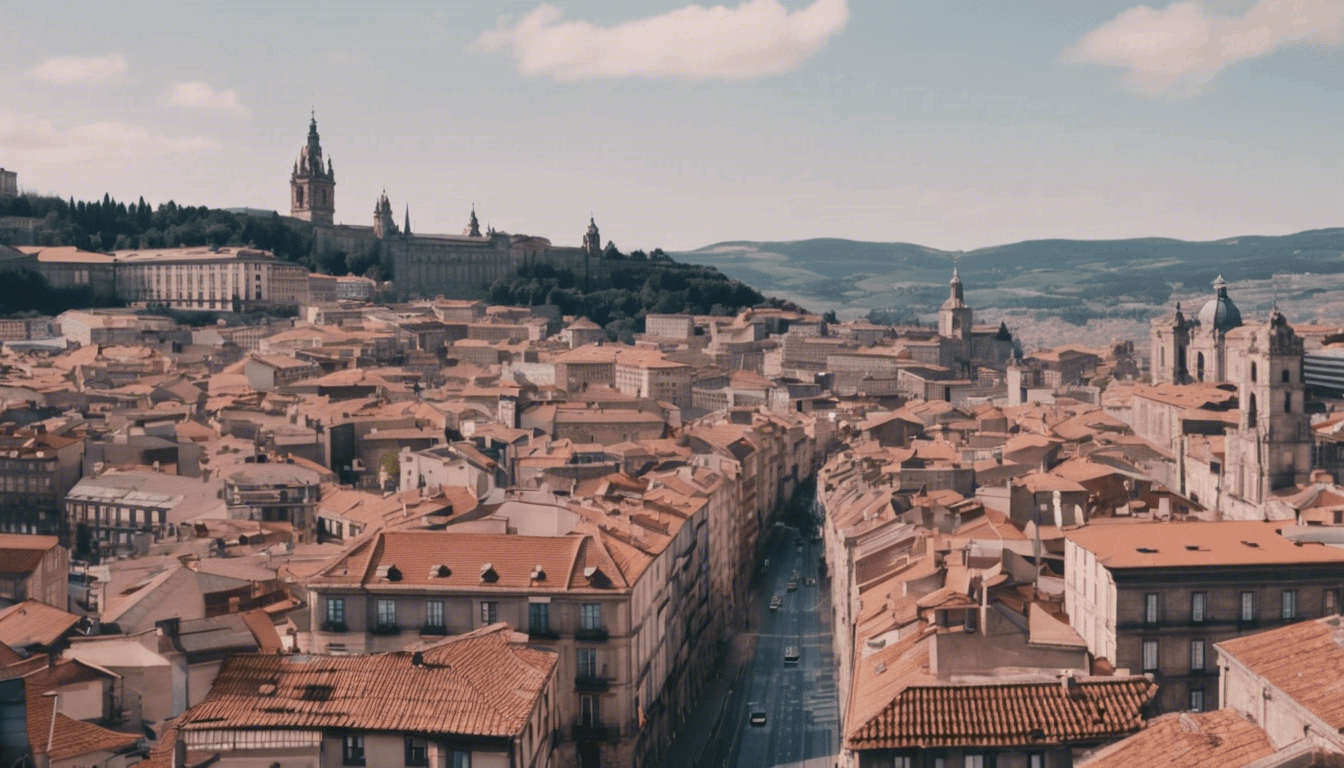
Navigating the City
If you are visiting a new city, you might be wondering how to get around and see the sights. There are many options for transportation and exploration, depending on your preferences, budget, and time. Here are some tips to help you navigate the city with ease.
Public Transportation
One of the most convenient and affordable ways to travel in a city is to use public transportation. Most cities have buses, subways, trams, or trains that can take you to different parts of the city quickly and cheaply. You can buy tickets or passes at stations, kiosks, or online. You can also use apps or websites to plan your routes, check schedules, and find nearby stops. Public transportation is also eco-friendly and reduces traffic congestion.
Bike Rentals
Another option for getting around the city is to rent a bike. Many cities have bike-sharing programs that allow you to borrow a bike from a station and return it to another one. You can pay by the hour or by the day, depending on how long you want to use the bike. Biking is a great way to exercise, enjoy the scenery, and avoid traffic jams. However, you should be careful of the traffic rules, road conditions, and weather when biking in a city.
Walking Routes
If you prefer to walk, you can also find many walking routes in a city that will show you the best places to visit. You can join a guided walking tour that will take you to the main attractions and landmarks of the city. You can also explore the city on your own by following maps, signs, or trails. Walking is a wonderful way to experience the culture, history, and atmosphere of a city. However, you should be aware of your surroundings, safety, and distance when walking in a city.
Navigating the city can be easy and fun if you know how to use the available options for transportation and exploration. Whether you choose public transportation, bike rentals, or walking routes, you can discover the city’s beauty and diversity. You can also gain some insights into the city’s layout to help you find your way and enjoy your trip.
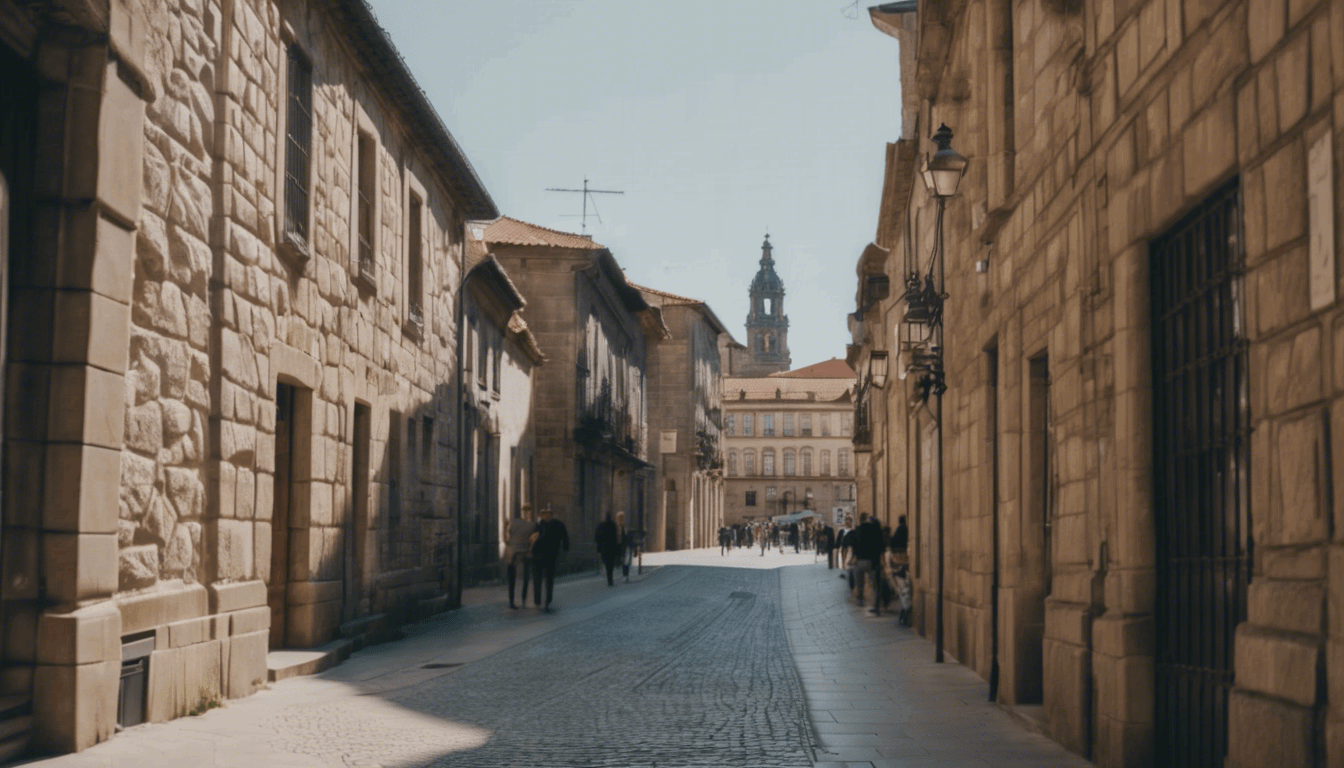
Major Attractions
If you are planning to visit, you cannot miss the opportunity to explore its magnificent cathedral, one of the most important and impressive monuments in Spain. The cathedral is not only a masterpiece of Romanesque, Gothic and Baroque architecture, but also a symbol of the Christian faith and a destination for millions of pilgrims who walk the Camino de Santiago every year. Here are some of the highlights of this amazing building and its surroundings.
The Cathedral of Santiago de Compostela
The cathedral is located in the heart of the historic center of Santiago, in the Plaza del Obradoiro, where you can admire its majestic western façade, also known as the Façade of Glory. This façade was built in the 18th century by Fernando de Casas y Novoa, and features a mix of Baroque and Neoclassical elements. It is decorated with statues of Saint James and other apostles, angels, prophets and allegorical figures. Above the main entrance, you can see a representation of the Last Judgment, with Christ surrounded by angels and saints.
The cathedral has three other façades: the southern one, facing the Plaza de las Platerías, which preserves the original Romanesque portal from the 12th century; the northern one, facing the Plaza de la Inmaculada, which was added in the 17th century and shows a Baroque style; and the eastern one, facing the Plaza de la Quintana, which was completed in the 17th century and has a Neoclassical design.
The interior of the cathedral is equally impressive, with a Latin cross floor plan and three naves. The main nave leads to the transept, where you can find the main altar and the crypt that contains the relics of Saint James and his disciples Theodorus and Athanasius.
The altar is a stunning example of Baroque art, with a silver-plated altarpiece that depicts scenes from the life of Saint James. Behind the altar, you can access the Pórtico da Gloria, a Romanesque masterpiece carved by Master Mateo in the 12th century. This portal shows more than 200 figures related to the Christian faith, such as Christ, Mary, apostles, prophets, angels and saints. It is considered one of the finest works of medieval sculpture in Europe.
Another remarkable feature of the cathedral is the Botafumeiro, a giant incense burner that hangs from the ceiling and swings across the transept during special occasions. The Botafumeiro weighs about 80 kg and measures 1.5 meters in height. It is operated by eight men called tiraboleiros, who pull ropes to make it move at a speed of up to 70 km/h. The Botafumeiro was originally used to create a pleasant smell and reduce the risk of infections among the pilgrims who crowded the cathedral.
The cathedral also has a rich museum that displays various artworks and historical objects related to its history and culture. The museum consists of several sections, such as the Treasury, where you can see precious items made of gold, silver and ivory; the Tapestry Room, where you can admire tapestries from different periods and styles; the Library, where you can browse through rare books and manuscripts; and the Cloister, where you can enjoy a peaceful walk around a beautiful garden.
Other must-visit historical sites, museums, parks, and attractions
The city has plenty to offer. The old town, declared a World Heritage Site by UNESCO in 1985, is a maze of narrow streets, stone houses, arches, and squares that preserve the medieval atmosphere of the city. Some of the most remarkable buildings are:
- The Hostal dos Reis Católicos, a former hospital for pilgrims founded by Ferdinand and Isabella in 1499, and now a luxurious hotel.
- The Pazo de Raxoi, an 18th-century palace that serves as the city hall and the seat of the Galician government.
- The Colexio de San Xerome, a 16th-century college that is part of the University, one of the oldest in Spain.
- The Monastery of San Martiño Pinario, a Benedictine abbey founded in the 10th century, with a splendid Baroque façade and cloister.
- The Monastery of San Paio de Antealtares, a Benedictine convent founded in the 9th century, where nuns sell delicious almond cakes (tarta de Santiago) through a revolving window.
Santiago de Compostela also has several museums that showcase its rich artistic and cultural heritage. Some of them are:
- Museo do Pobo Galego (Museum of Galician People), located in a former convent, which exhibits collections of folk art, costumes, tools, musical instruments, and crafts from Galicia.
- Centro Galego de Arte Contemporánea (Galician Center of Contemporary Art), designed by Portuguese architect Álvaro Siza Vieira, which displays works by modern and contemporary artists from Galicia and beyond.
- Museo das Peregrinacións e de Santiago (Museum of Pilgrimages and Santiago), which explores the history, art, and spirituality of the Camino de Santiago and its impact on the city.
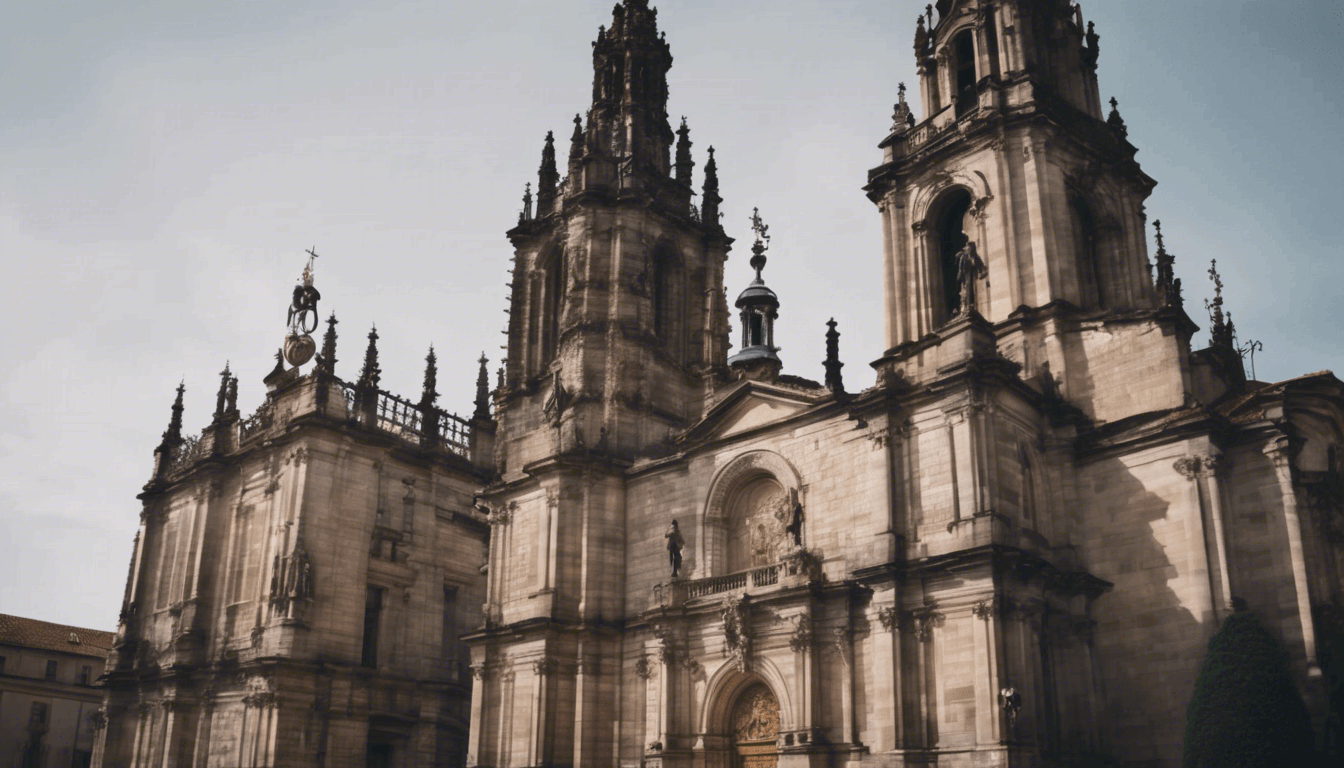
Food and Drink
If you are looking for a culinary adventure in Spain, you should definitely visit Galicia, the region in the northwest corner of the country. Galicia is famous for its seafood, which is fresh, diverse and delicious. In this blog post, I will introduce you to some of the most typical Galician seafood dishes and give you some recommendations on where to try them, the capital of Galicia and a popular destination for pilgrims and tourists alike.
Galician Seafood Dishes
Pulpo a la gallega: This is probably the most iconic dish of Galicia. It consists of boiled octopus cut into slices and seasoned with olive oil, paprika and salt. It is usually served on a wooden plate with boiled potatoes. You can find pulpo a la gallega in almost any restaurant or bar in Galicia, but one of the best places to try it is O Gato Negro, a traditional tavern in the old town that specializes in octopus.
Almejas a la marinera: This is a classic dish of clams cooked in a sauce made with onion, garlic, parsley, white wine and paprika. It is a simple but flavorful dish that goes well with bread to soak up the sauce. You can enjoy almejas a la marinera in many seafood restaurants, but one of the most renowned ones is Casa Marcelo, a Michelin-starred restaurant that offers a modern and creative twist on Galician cuisine.
Mejillones rellenos: These are stuffed mussels that are baked in the oven with a filling made with chopped mussel meat, onion, garlic, bread crumbs, egg and parsley. They are also known as tigres (tigers) because of their spicy flavor. They are a popular tapa or appetizer that you can find in many bars and restaurants in Galicia. One of the best places to try them in is A Taberna do Bispo, a cozy and lively place that serves a variety of tapas and wines.
Merluza a la gallega: This is a dish of hake, a white fish that is very common in Galicia, cooked with potatoes, onion, garlic, bay leaf and olive oil. It is a simple but satisfying dish that showcases the quality and freshness of the fish. You can order merluza a la gallega in many restaurants, but one of the most recommended ones is O Dezaseis, a charming restaurant that occupies an old stone house and serves traditional Galician dishes with a touch of sophistication.
Vieiras: These are scallops that are served in their shells, usually baked with bread crumbs, cheese and ham. They are also a symbol of Galicia and the Camino de Santiago, as many pilgrims wear scallop shells as badges or pendants. You can taste vieiras in many seafood restaurants, but one of the most authentic ones is O Curro da Parra, a rustic and cozy restaurant that offers seasonal and local products.
Arroz con bogavante: This is a rice dish cooked with lobster and other seafood such as clams, mussels and prawns. It is similar to paella but more soupy and rich. It is a festive and indulgent dish that you can find in some of the best seafood restaurants in Galicia. One of the places where you can try it is Casa Pintos, a family-run restaurant that has been serving excellent seafood since 1929.
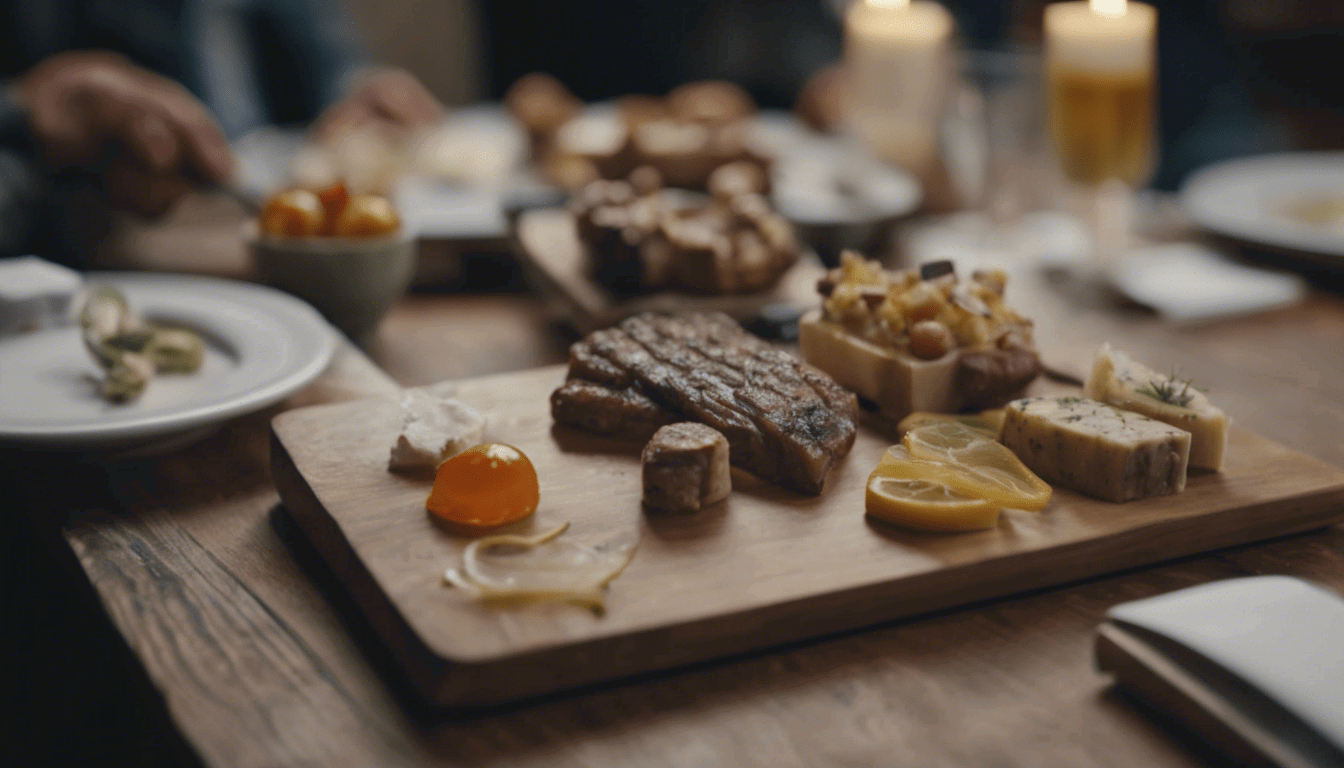
Best Restaurants in Santiago de Compostela for any Budget
From seafood and meat dishes to tapas and desserts. Here are some of the best restaurants to try, whether you are looking for a cheap bite, a fine dining experience, or something in between.
| Rank | Name | Cuisine/Style | Price Range | Address | Phone |
|---|---|---|---|---|---|
| 1 | Casa Marcelo | Creative/Contemporary | $$$$ | Rúa das Hortas 1, Santiago de Compostela | +34 (981) 55 85 80 |
| 2 | O Curro da Parra | Mediterranean/Spanish | $$$ | Rúa da Trinidade 20, Santiago de Compostela | +34 (981) 56 30 99 |
| 3 | A Taberna do Bispo | Tapas Bar | $$ | Rúa do Franco 37 B, Santiago de Compostela | +34 (981) 58 60 45 |
| 4 | Restaurante Dos Reis Parador de Santiago | Galician Classic | $$$$ | Praza do Obradoiro 1, Santiago de Compostela | +34 (981) 58 22 00 |
| 5 | Milongas Tapería | Tapas/Beerhouse | $ | Rúa Preguntoiro 9, Santiago de Compostela | +34 (981) 56 27 08 |
| 6 | O Gato Negro | Traditional Galician | $ | Rúa Raina s/n, Santiago de Compostela | +34 (981) 58 31 05 |
| 7 | La Flor | Indian/Mediterranean Fusion | $ | Rúa do Preguntoiro 30, Santiago de Compostela | +34 (981) 57 64 21 |
| 8 | Santiago Kyoto | Japanese | $$ | Rúa do Horreo 31-33 Bajo 2B, Santiago de Compostela | +34 (981) 56 39 39 |
| 9 | Los Caracoles | Seafood/Snails | $$ | Rúa do Franco 50-52 Bajo, Santiago de Compostela | +34 (981) 58 70 06 |
| 10 | Restaurante Enxebre - Parador de Santiago | Casual Galician | $$ | Praza do Obradoiro s/n - Parador de Santiago de Compostela - Hostal dos Reis Católicos - Entrada por Rúa das Hortas 4A | +34 (981) 58 22 00 |
1. Casa Marcelo Casa Marcelo is one of the most renowned restaurants in Santiago de Compostela, and the only one with a Michelin star. The chef, Marcelo Tejedor, offers a creative and contemporary cuisine that combines local ingredients with Asian influences. The menu changes daily according to the market availability, and you can choose between a tasting menu or à la carte dishes. Some of the specialties include scallops with seaweed, pork belly with kimchi, or chocolate cake with passion fruit. The restaurant is located in a historic building near the cathedral, and has a minimalist and elegant decor.
2. O Curro da Parra O Curro da Parra is a cozy and modern restaurant that serves Mediterranean and Spanish cuisine with a twist. The menu features seasonal and organic products, and offers dishes such as octopus carpaccio, lamb shank with couscous, or apple pie with vanilla ice cream. The restaurant also has a good selection of wines and cocktails, and a terrace where you can enjoy the views of the old town.
3. A Taberna do Bispo A Taberna do Bispo is a popular tapas bar in the emblematic Rúa do Franco, where you can find many traditional restaurants and taverns. The place has a small and familiar atmosphere, where you can taste some of the best tapas in town, such as croquettes, empanadas, cheese boards, or grilled prawns. The portions are generous and the prices are reasonable, and you can also order some of the local wines or beers to accompany your meal.
4. Restaurante Dos Reis Parador de Santiago If you want to splurge on a special occasion, you can book a table at the Restaurante Dos Reis Parador de Santiago, located inside the Parador Hotel, a former royal hospital from the 15th century. The restaurant offers a refined and elegant setting, where you can enjoy some of the classic Galician dishes, such as pulpo á feira (octopus with paprika), lacón con grelos (pork shoulder with turnip greens), or tarta de Santiago (almond cake). The service is impeccable and the wine list is extensive.
5. Milongas Tapería Milongas Tapería is a cheerful and colorful beerhouse and tapas bar in the Zona Vella (old town). The place has a lively atmosphere and a friendly staff, and offers a variety of tapas and raciones (larger portions) that you can share with your friends or family. Some of the specialties include patatas bravas (spicy potatoes), tortilla española (Spanish omelette), croquetas de jamón (ham croquettes), or calamares fritos (fried squid). The place also has a privileged terrace in the area of the Pescadería Vella (old fish market), where you can enjoy your food and drinks outdoors.
6. O Gato Negro O Gato Negro (The Black Cat) is one of the oldest and most emblematic taverns, dating back to 1929. The place has a rustic and cozy decor, with wooden tables and benches, and a large black cat statue at the entrance. The menu offers traditional Galician cuisine, such as caldo gallego (Galician soup), pimientos de Padrón (fried green peppers), or churrasco (grilled meat). The portions are large and the prices are affordable, and you can also order some of the homemade desserts, such as flan (custard) or arroz con leche (rice pudding).
7. La Flor La Flor is a charming cafe and restaurant that offers a fusion of Indian and Mediterranean cuisine. The place has a bright and cozy interior, with colorful cushions, paintings, and flowers. The menu features dishes such as samosas, curries, salads, wraps, or burgers, all made with fresh and organic ingredients. The place also has a variety of teas, coffees, juices, and smoothies, as well as vegan and gluten-free options. La Flor is a great place to have a relaxing breakfast, brunch or lunch.
8. Santiago Kyoto Santiago Kyoto is a Japanese restaurant that offers a wide range of sushi, sashimi, tempura, noodles, and other Asian dishes. The place has a modern and minimalist decor, with wooden furniture and red accents. The food is fresh and well-presented, and you can choose between different menus or à la carte options. Some of the highlights include the dragon roll, the yakisoba, or the teriyaki chicken. The restaurant also has a delivery service and a loyalty program for regular customers.
9. Los Caracoles Los Caracoles (The Snails) is a seafood restaurant that specializes in snails cooked in different ways, such as with garlic, tomato sauce, or spicy sauce. The place has a simple and casual decor, with wooden tables and chairs, and a large display of fresh seafood at the entrance. The menu also offers other seafood dishes, such as mussels, clams, scallops, or crab. The portions are generous and the prices are reasonable, and you can also order some of the local wines or beers to wash down your meal.
10. Restaurante Enxebre - Parador de Santiago Restaurante Enxebre - Parador de Santiago is another restaurant located inside the Parador Hotel, but this one offers a more casual and affordable option than the Dos Reis one. The restaurant serves typical Galician dishes, such as empanada gallega (Galician pie), queixo con membrillo (cheese with quince jelly), or lacón con grelos (pork shoulder with turnip greens). The place has a rustic and cozy atmosphere, with stone walls and wooden beams. The service is friendly and efficient, and the portions are satisfying.
Shopping
This is a great place for shopping, especially if you are looking for unique and traditional products from Galicia. Here are some of the best places to go shopping in the city, depending on your budget and preferences.
Local markets and shopping districts
-
If you want to experience the local culture and buy fresh produce, head to the Mercado de Abastos, the historic covered market where you can find everything from cheese and ham to seafood and vegetables. You can also sample some of the delicacies at the stalls or at the nearby bars and restaurants.
-
If you are looking for international brands and a modern shopping mall, visit the Centro Comercial As Cancelas, where you can find a variety of shops, a supermarket, a cinema and a food court. It is located a few kilometers from the city center, but you can easily reach it by bus or taxi.
-
If you prefer to shop in the quaint streets of the Old Town, you can explore the Rúas Nova, Vilar, San Pedro, Caldeirería, Preguntoiro and the Plazas Toural and Cervantes, where you will find a mix of artisanal shops, boutiques, gift shops and Galician fashion stores. Some of the best shops in this area are:
- Sargadelos, a celebrated ceramic brand that sells colorful and original pieces, from dishes and figurines to jewellery and textiles.
- Casal Cotón, a family-run deli that offers a selection of Galician products, such as tarta de Santiago (almond cake), Tetilla cheese, wine and liquor.
- Joyeria Ramón González Orfebres, a jewellery store that specializes in jet (azabache), a black mineral stone that is believed to protect pilgrims who have walked the Camino de Santiago.
- Marta Barcala, a fashion store that sells elegant and sophisticated clothes and accessories for women, designed by the owner herself.
Unique souvenirs and Galician products
If you want to bring back something special, here are some of the best souvenirs and products that you can buy:
- A scallop shell, the symbol of the Camino de Santiago and its pilgrims. You can find them in many shops and stalls around the cathedral, or even collect them yourself along the coast.
- A botafumeiro, a replica of the giant incense burner that swings across the cathedral during special occasions. You can buy a small version of it as a pendant or a keychain, or a larger one as a decorative item.
- A Galician cookbook, to learn how to make some of the delicious dishes that you have tasted duringyour visit, such as pulpo á feira (octopus with paprika), empanada gallega (savory pie) or caldo gallego (hearty soup).
- A Galician musical instrument, such as a gaita (bagpipe), a tamboril (drum) or a pandeireta (tambourine), to play some of the traditional tunes that you have heard in the streets or at festivals.
- A Galician handicraft, such as a basket made of chestnut wood, a lace doily made of linen or cotton, or a pottery piece made of clay or porcelain.
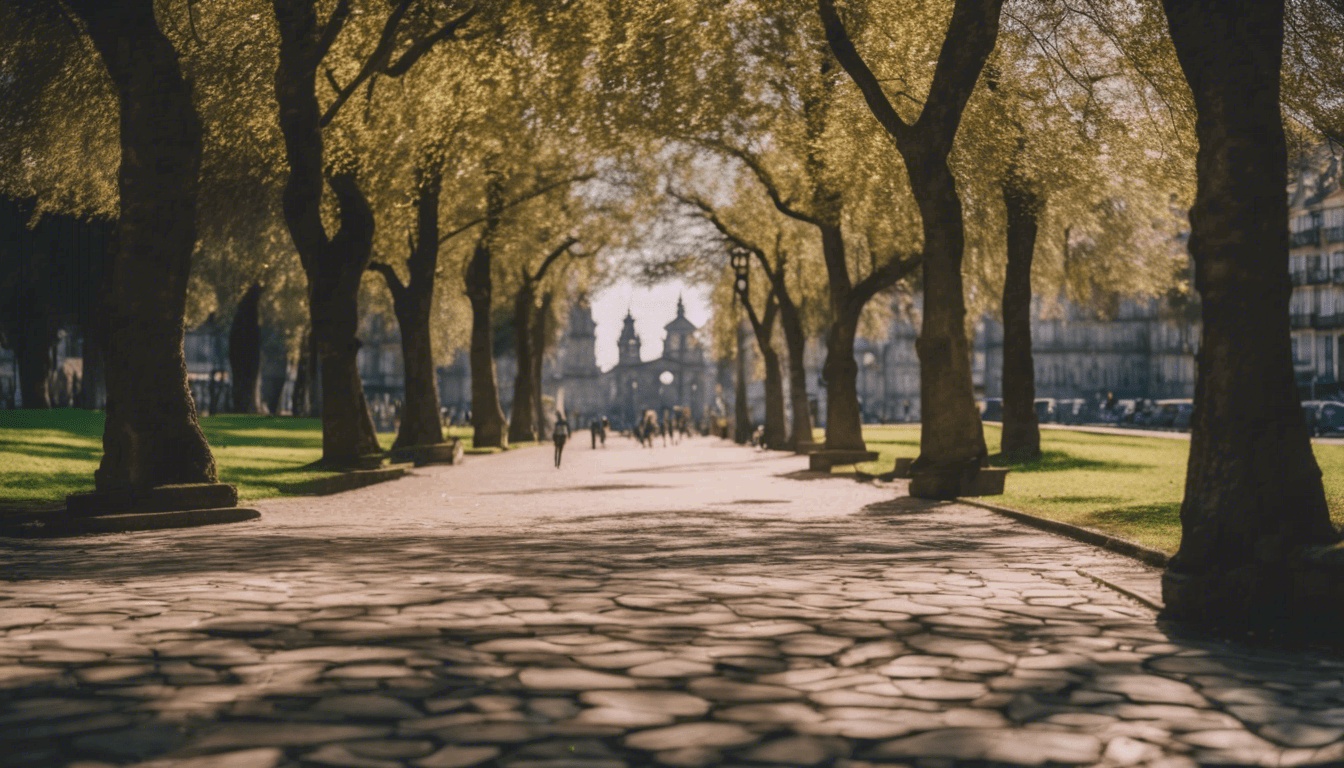
Outdoor and Leisure Activities
If you are looking for some outdoor and leisure activities to enjoy the natural beauty of Galicia, here are some recommendations for parks, nature excursions, and day trips that will suit different budgets and preferences.
Parks
One of the best places to enjoy nature is the Parque Alameda, a large park that dates back to the 19th century and offers stunning views of the cathedral and the old town. You can walk among centuries-old oak trees, admire the sculptures and fountains, or relax on a bench and watch the locals and pilgrims go by. The park is free to enter and open all year round.
Another park worth visiting is the Parque de Belvís, located on a hill near the old town. This park has a more rural and natural feel, with meadows, orchards, and gardens. You can also find some historical monuments, such as a medieval tower and a convent. The park is a great place to enjoy a picnic or a sunset, and it is also free to enter and open all year round.
Nature excursions
If you want to explore the countryside around thecity, you have plenty of options for nature excursions. One of them is to take a self-guided tour of the last 10 kilometers of the Camino de Santiago, from Monte do Gozo to the cathedral.
This way, you can get a taste of the pilgrimage experience and see some of the landmarks along the way, such as the Monument to Pilgrims, the Chapel of San Marcos, and the Porta do Camiño. You can do this walk on your own or join a guided group tour that includes transportation and a certificate of completion.
Another option is to take a boat tour along the Galician waterways, such as the Rías Baixas or the Ribeira Sacra. These are coastal inlets or river canyons that offer spectacular scenery and wildlife. You can also visit some of the charming villages, wineries, and monasteries that dot the shores. You can book a boat tour online or at one of the tourist offices.
Day trips
This location is also a great base for day trips to other destinations in Galicia. One of them is A Coruña, a coastal city that boasts a rich maritime history and culture. You can visit its main attractions, such as the Tower of Hercules (a UNESCO World Heritage Site), the Castle of San Antón, and the Aquarium Finisterrae. You can also enjoy its beaches, promenades, and gastronomy.
Another day trip idea is to visit the Cíes Islands, a natural paradise in the Atlantic Ocean that forms part of the Galician Atlantic Islands National Park. You can take a ferry from Vigo or Baiona and spend a day hiking, swimming, snorkeling, or birdwatching on these islands.
You can also admire their white sand beaches, cliffs, lagoons, and forests. The islands are only open from June to September and have limited capacity, so you need to book your tickets in advance.
These are just some of the outdoor and leisure activities that you can enjoy with varying budgets.
Cultural Experiences
If you are looking for some cultural experiences, you have plenty of options to choose from, no matter what your budget is. Santiago is a city rich in history, art, and spirituality, and you can find something to suit your interests and preferences. Here are some ideas for how to immerse yourself in the local culture.
Calendar of Cultural Events
One of the best ways to discover the culture of Santiago is to check out the calendar of events that take place throughout the year. You can find festivals, concerts, exhibitions, theater, and more, covering a variety of topics and genres. Some of the most popular events are:
- The Feast of St. James (July 25): This is the patron saint of Santiago and one of the most important celebrations in the city. You can enjoy fireworks, music, dancing, and traditional food, as well as witness the arrival of pilgrims who have completed the Camino de Santiago.
- The Festival of Contemporary Culture (September): This is a multidisciplinary festival that showcases the latest trends in art, music, cinema, literature, and more. You can attend workshops, exhibitions, screenings, concerts, and talks by local and international artists and creators.
- The International Celtic Music Festival (October): This is a festival that celebrates the Celtic roots of Galicia and its connection with other regions of Europe. You can listen to folk music from different countries, learn about Celtic traditions and legends, and participate in activities such as workshops, games, and crafts.
Calendar of Religious Events
As the final destination of the Camino de Santiago, this a city of faith and spirituality. If you are interested in exploring the religious aspect of the city, you can find many events that reflect its devotion and heritage. Some of the most notable are:
- Holy Week (March or April): This is a week-long celebration that commemorates the passion, death, and resurrection of Jesus Christ. You can watch processions of religious brotherhoods carrying statues and crosses through the streets, accompanied by music and candles. Holy Week is a series of important religious events that occur over Easter in Santiago de Compostela .
- Ascension Day (May or June): This is a day that marks the ascension of Jesus to heaven after his resurrection. You can see a representation of this event in the Cathedral of Santiago, where a giant incense burner called the Botafumeiro swings across the nave at high speed.
- The Immaculate Conception (December 8): This is a day that honors the conception of Mary without original sin. You can visit the Church of San Francisco, where there is a statue of Mary that is said to have miraculous powers. You can also enjoy a fair with stalls selling sweets, crafts, and flowers.
Local Arts and Music Scene
If you want to experience the arts and music scene of Santiago, you have many options to choose from, depending on your taste and budget. You can find venues that offer live performances, museums that display works of art, and places where you can learn new skills or express your creativity. Here are some suggestions for how to engage with the local arts and music scene.
- Visit the City of Culture: This is a complex of buildings designed by architect Peter Eisenman that hosts cultural events and exhibitions. You can find a library, a museum, an auditorium, and a center for innovation and entrepreneurship. You can also admire the architecture and enjoy the views from the rooftop.
- Go to a Jazz Club: If you love jazz music, you can find several clubs in Santiago that offer live shows by local and international musicians. Some of the most popular ones are Jazz Club Dado Dada, Borriquita de Belém, and Jazz Filloa.
- Take a Painting Class: If you want to unleash your artistic potential, you can take a painting class at one of the many studios in Santiago. You can learn different techniques and styles from professional artists and create your own masterpiece. Some of the studios that offer painting classes are Arte en Vivo, Pintura Creativa Galicia, and Atelier de Pintura.
Practical Information for visitors
Here are some tips on local transportation, weather, currency, safety, and etiquette, as well as information on accessibility, healthcare facilities, and emergency contacts.
Transportation
Santiago has a small airport that connects with several domestic and international destinations. You can take a bus or a taxi from the airport to the city center, which takes about 20 minutes and costs around 3 euros or 20 euros, respectively.
The city is also well connected by train and bus with other major cities in Spain and Portugal. The train station is located near the historical center and offers regular and high-speed services. The bus station is a bit further away, but you can take a local bus or a taxi to get to your accommodation.
Once in the city, you can easily explore most of the attractions on foot, as the old town is compact and pedestrian-friendly. There are also public buses that cover different routes around the city and its surroundings. You can buy tickets on board or get a rechargeable card at the tourist office or some kiosks. A single ticket costs 1 euro and a card costs 2 euros plus the amount you want to charge.
If you prefer more flexibility, you can also rent a car, a bike, or an electric scooter from various companies in the city. However, be aware that parking and driving in the old town can be challenging due to narrow streets and restricted areas.
Weather
This region has an oceanic climate with mild temperatures and high humidity throughout the year. The average temperature ranges from 9°C in January to 19°C in August. The city is known for its frequent rainfall, especially in winter and spring, so be prepared for wet weather and bring an umbrella or a raincoat.
The best time to visit is from June to September, when the weather is warmer and drier, and there are more cultural events and festivals. However, this is also the peak season for tourism and the Camino de Santiago, so expect higher prices and crowds. If you want to avoid the crowds and enjoy lower prices, you can visit in autumn or winter, but be ready for colder and rainier days.
Currency
The currency used is the euro (EUR), which is divided into 100 cents. You can exchange your money at banks, exchange offices, or ATMs, which are widely available in the city. You can also pay with credit or debit cards at most shops, restaurants, and hotels, but some may charge a small fee or have a minimum amount. It is advisable to have some cash on hand for small purchases or tips.
The cost of living in the city is lower than in other major Spanish cities, but higher than in other parts of Galicia. You can expect to pay around 50 euros per night for a double room in a mid-range hotel, 10-15 euros for a meal in a local restaurant, and 2-3 euros for a coffee or a beer.
Safety
Santiago is generally a safe city with a low crime rate. However, as in any tourist destination, you should be careful of pickpockets and scammers, especially in crowded areas or public transport. Keep your valuables close to you and do not leave them unattended. Avoid walking alone at night in dark or isolated streets and be aware of your surroundings.
If you are doing the Camino de Santiago, you should also take some precautions to ensure your safety and comfort. Plan your route ahead and check the weather forecast. Wear comfortable shoes and clothing and carry enough water and snacks. Do not carry too much weight or valuables in your backpack. Stay on marked trails and do not wander off alone. Respect the nature and the locals and follow the rules of the albergues (pilgrim hostels).
In case of an emergency, you can call 112 for free from any phone for police, fire brigade, or ambulance services.
Etiquette
Santiago is a friendly and welcoming city. To make the most of your visit and avoid any cultural misunderstandings, here are some etiquette tips to keep in mind:
- Greet people with a handshake or two kisses on the cheek (one on each side), depending on the level of familiarity.
- Use formal titles (usted) when addressing older people or strangers, unless they invite you to use the informal ones (tú).
- Be punctual for appointments or meetings, but do not expect the same from others, as Spaniards tend to be more relaxed about time.
- Dress modestly and respectfully when visiting churches or other religious sites. Cover your shoulders and knees and remove your hat or sunglasses.
- Tip around 10% of the bill in restaurants or bars, unless the service charge is included. You can also leave some small change for taxi drivers or hotel staff.
- Learn some basic words and phrases in Spanish or Galician, the co-official language of the region. Most people speak both languages, but some may appreciate your effort to communicate in their native tongue.
Accessibility
While it is a relatively accessible city for people with disabilities or reduced mobility, the city still has some challenges and limitations. The old town has many cobblestone streets and steps that can make it difficult to navigate with a wheelchair or a walker. However, there are also some ramps, elevators, and adapted sidewalks that can facilitate the access to some monuments and buildings.
The public transport system is also partially accessible, with some buses and taxis equipped with ramps or lifts. The train and bus stations have accessible facilities and services, such as toilets, parking spaces, or assistance. The airport has a special service for passengers with reduced mobility that can be requested in advance.
There are also some hotels, restaurants, and tourist attractions that have adapted rooms, entrances, or information for people with disabilities. You can check their websites or contact them directly to confirm their accessibility features. You can also find more information and resources on the official tourism website.
Healthcare Facilities
The public healthcare system provides free or low-cost medical services to residents and visitors from the European Union (EU), the European Economic Area (EEA), or Switzerland who have a European Health Insurance Card (EHIC). If you are from one of these countries, you should bring your EHIC with you and present it at any public hospital or health center if you need medical attention.
If you are from a non-EU/EEA/Swiss country, you should have a valid travel insurance that covers your medical expenses in Spain. Otherwise, you may have to pay for the full cost of the treatment, which can be very expensive. You should also bring any prescription medication that you need with you, as well as a copy of your prescription in Spanish.
The main public hospital is the Hospital Clínico Universitario de Santiago de Compostela (CHUS), which is located at Travesía da Choupana s/n. You can call +34 (981) 950 000 for general information or +34 (981) 950 951 for emergencies. There are also several health centers (centros de salud) and pharmacies (farmacias) throughout the city. You can find their locations and contact details on the official health website of Galicia.
Emergency Contacts
Here are some useful phone numbers that you may need in case of an emergency:
- 112: General emergency number for police, fire brigade, or ambulance services.
- 091: National police number for reporting crimes or incidents.
- 092: Local police number for traffic or municipal issues.
- 061: Health emergency number for urgent medical assistance.
- +34 (981) 563 777 : Tourist office number for information or assistance.
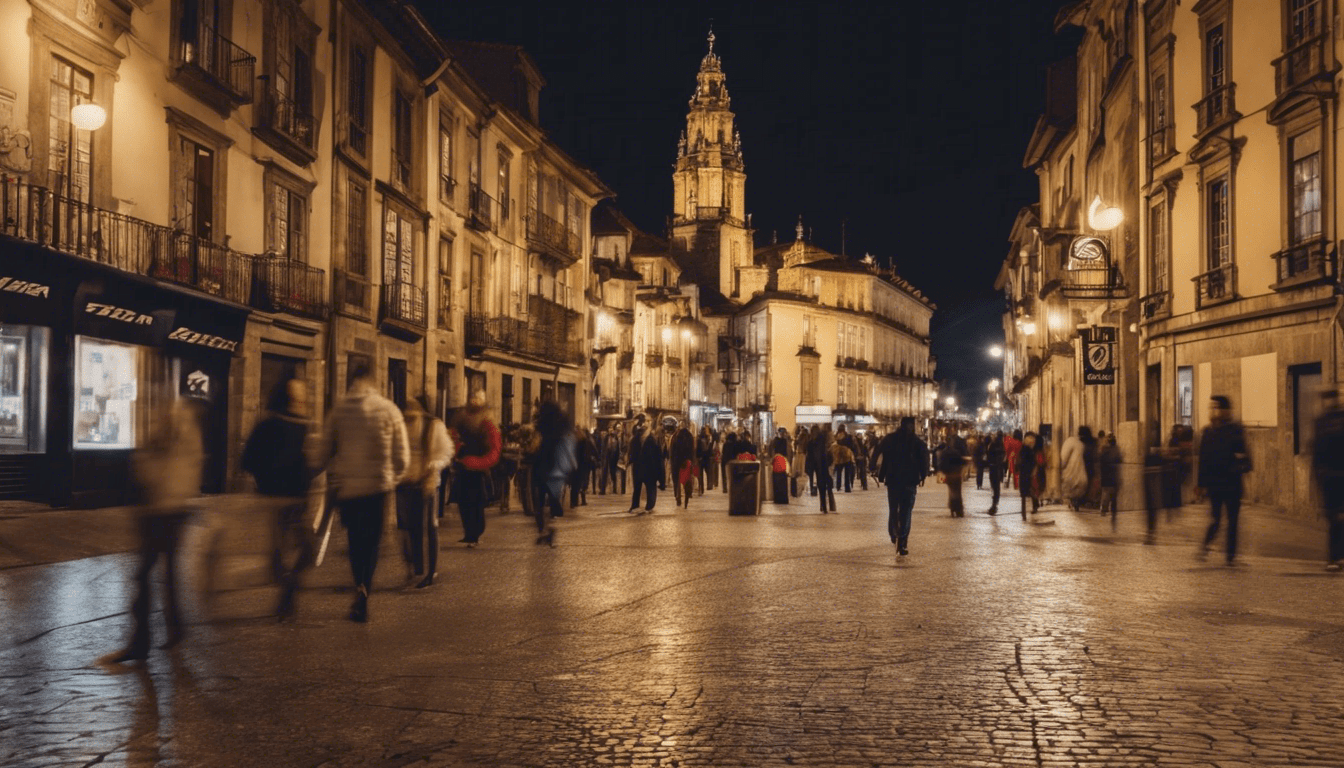
Nightlife in Santiago de Compostela
Santiago is a city of nightlife and entertainment. Whether you are looking for a relaxing drink, a lively party, or a live music show, you will find plenty of options to suit your mood and taste in this vibrant Galician capital.
Overview of Santiago’s nightlife from taverns to clubs
Santiago’s nightlife is concentrated in the historic center, where you can find a variety of bars, pubs, and clubs catering to different crowds and styles. The most popular areas are the Rúa do Franco, the Rúa da Raíña, and the Praza de Cervantes, where you can enjoy the traditional taverns and tapas bars that serve local wines and beers, as well as delicious Galician specialties like pulpo á feira (octopus with paprika), empanada (savory pie), or pimientos de Padrón (fried green peppers).
If you are looking for more modern and trendy venues, you can head to the Rúa Nova, the Rúa do Vilar, or the Praza das Praterías, where you will find cocktail bars, wine bars, and craft beer pubs that offer a more sophisticated and cosmopolitan atmosphere. Here you can sip on exotic drinks like mojitos, caipirinhas, or pisco sours, or taste some of the best Galician wines and ciders.
For those who want to dance the night away, Santiago has a wide range of clubs and discos that play different genres of music, from pop and rock to salsa and reggaeton. Some of the most popular clubs are Chocolate, Delusx, and A Novena Porta, which are open until late and attract a young and energetic crowd. If you prefer live music, you can check out some of the venues that host concerts and shows regularly, such as Modus Vivendi, A Reixa, or Borriquita de Belem, where you can listen to jazz, blues, rock, or flamenco.
Tips for local music and entertainment
The city has a rich musical and cultural heritage, and you can experience it first-hand by visiting some of the places that showcase the local talent and traditions. One of them is Pub Atlántico, which is considered one of the best bars in Spain for its quality cocktails and its eclectic music selection. Here you can enjoy live performances by local and international artists, ranging from Cajun blues to Spanish indie.
Another place that offers a unique musical experience is Pub Momo, which has a beautiful garden where you can relax and enjoy the sounds of nature. This pub also hosts live music events every week, featuring genres like folk, Celtic, or world music. You can also join one of their jam sessions or workshops if you want to learn more about the instruments and techniques used in these styles.
If you want to discover the traditional Galician music and dance, you should not miss Casal Cotón, which is a cultural association that promotes the Galician culture and language. Here you can watch or participate in folk dances like muiñeira or jota, or listen to typical instruments like gaita (bagpipe), pandeiro (tambourine), or zanfona (hurdy-gurdy). You can also enjoy some of their gastronomic events that feature local products like cheese, honey, or chestnuts.
This is a city that never sleeps, and you will always find something to do after dark. Whether you want to have a quiet drink with friends, party until dawn, or immerse yourself in the local culture, you will find your perfect spot in this lively and charming city.
Santiago de Compostela Travel Guide Video
Tips for Sustainable Tourism
Santiago de Compostela is a beautiful city, that attracts millions of pilgrims and tourists every year. It is the final destination of the Camino de Santiago, a network of ancient routes that lead to the cathedral where the remains of Saint James are said to be buried. The city is a UNESCO World Heritage Site, with a rich historical and cultural heritage.
If you are planning to visit, you might wonder how to do it in a sustainable way, respecting the environment and the local community. Here are some tips to help you enjoy this amazing place while minimizing your impact:
- Use your own water bottle. Along the Camino route and in the city, you will find many fountains where you can refill your bottle with fresh and clean water. This way, you will avoid buying plastic bottles that end up in landfills or oceans.
- Carry a waste bag. Sometimes, you might not find a rubbish bin nearby, especially if you are walking through natural areas. Make sure to collect your waste and dispose of it properly when you find a bin. Do not litter or leave anything behind.
- Participate in the community. One of the best things about this destination is the friendly and welcoming atmosphere that you will find among locals and visitors. You can join some of the activities that are organized by the city council, such as guided tours, cultural events, workshops, etc. You can also volunteer for some of the associations that work to preserve and promote the Camino de Santiago, such as cleaning or restoring some parts of the route.
- Support local businesses. When you shop, eat or stay, try to choose local and ethical options. This way, you will contribute to the local economy and culture, and reduce your carbon footprint. You can also buy some souvenirs that are made by local artisans or producers, such as pottery, jewelry, cheese, wine, etc.
- Respect the heritage. This city has a remarkable architectural and artistic legacy that deserves to be admired and protected. When you visit the cathedral or any other monument, follow the rules and recommendations that are given by the staff or signs. Do not touch, damage or graffiti anything. Also, respect the religious beliefs and practices of the pilgrims and locals who visit the cathedral or other sacred places.
- Be mindful of your behavior. This is a lively and vibrant city, but also a peaceful and quiet one. Try to adapt to the rhythm and customs of the place, and avoid being noisy or disruptive. Especially at night, when many people rest after a long day of walking or sightseeing. Also, be polite and courteous with everyone you meet, and learn some basic words in Galician or Spanish to communicate better.
